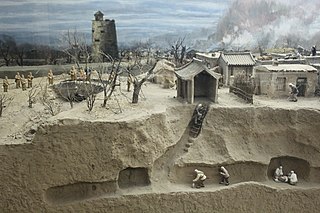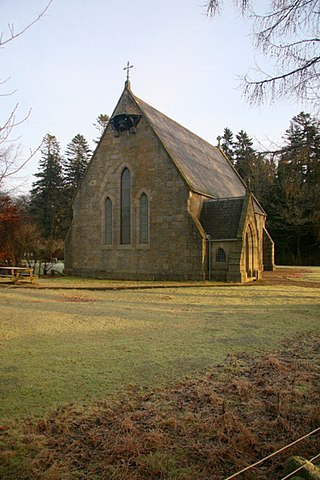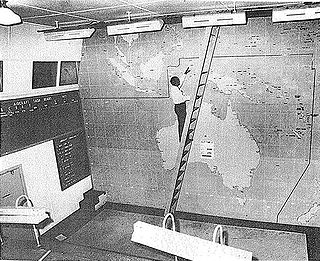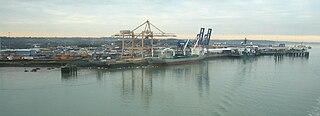

Scallywag bunkers or Auxiliary Unit Operational Base/OB were underground bunkers used by GHQ Auxiliary Units of the British Resistance against axis invasion of the United Kingdom. [1] [2] [3] [4] [5]


Scallywag bunkers or Auxiliary Unit Operational Base/OB were underground bunkers used by GHQ Auxiliary Units of the British Resistance against axis invasion of the United Kingdom. [1] [2] [3] [4] [5]
Operational Patrols consisted of between four and eight men, often farmers or landowners. They were usually recruited from the most able members of the Home Guard, possessed excellent local knowledge and were able to live off the land. Gamekeepers and even poachers were particularly valued. [6] They were always intended to fight in Home Guard uniform and from 1942 the men were badged to Home Guard battalions 201 (Scotland), 202 (northern England), or 203 (southern England).[ citation needed ]
Around 3,500 men were trained on weekend courses at Coleshill House, near Highworth, Wiltshire, in the arts of guerrilla warfare including assassination, unarmed combat, demolition and sabotage.[ citation needed ]
Each Patrol was a self-contained cell, expected to be self-sufficient and operationally autonomous in the case of invasion, generally operating within a 15-mile radius. They were provided with elaborately-concealed underground Operational Bases (OB), [7] [8] usually built by the Royal Engineers in a local woodland, with a camouflaged entrance and emergency escape tunnel. [9] It is thought that 400 to 500 such OBs were constructed in England, Wales and Scotland. [9]

A fortification is a military construction designed for the defense of territories in warfare, and is used to establish rule in a region during peacetime. The term is derived from Latin fortis ("strong") and facere.

Air raid shelters are structures for the protection of non-combatants as well as combatants against enemy attacks from the air. They are similar to bunkers in many regards, although they are not designed to defend against ground attack.

Continuity of government (COG) is the principle of establishing defined procedures that allow a government to continue its essential operations in case of a catastrophic event such as nuclear war.
The Auxiliary Units, Home Guard Shock Squads or GHQ Auxiliary Units were specially trained, highly secret quasi military units created by the British government during the Second World War with the aim of using irregular warfare in response to a possible invasion of the United Kingdom by Nazi Germany, "Operation Sea Lion". With the advantage of having witnessed the rapid fall of several Continental European nations, the United Kingdom was the only country during the war that was able to create a multilayered guerrilla force in anticipation of an invasion.

The Battle of Wizna was fought between September 7 and September 10, 1939, between the forces of Poland and Germany during the initial stages of the invasion of Poland, which marked the beginning of the Second World War in Europe. According to Polish historian Leszek Moczulski, between 350 and 720 Poles defended a fortified line for three days against more than 40,000 Germans. Although defeat was inevitable, the Polish defence stalled the attacking forces for three days and postponed the encirclement of Independent Operational Group Narew fighting nearby. Eventually the tanks broke through the Polish line and German engineers eliminated all the shelters one by one. The last shelter surrendered around midday on September 10.

Anthony Ashley-Cooper, Lord Ashley, OStJ, TD, DL, was a British Army officer. As the eldest son of Anthony Ashley-Cooper, 9th Earl of Shaftesbury, he used the courtesy title "Lord Ashley".

Parham Airfield Museum is a museum in Framlingham in Suffolk, England. The airfield was named after the village of Parham in Suffolk famously linked to the Aldeburgh poet George Crabbe.

RAF Rudloe Manor, formerly RAF Box, was a Royal Air Force station north-east of Bath, England, between the settlements of Box and Corsham, in Wiltshire. It was one of several military installations in the area and covered three dispersed sites. Parts of the site are now used by Defence Digital within the MoD Corsham complex; other areas are vacant and some have been sold, including the 17th-century manor house, Rudloe Manor.

Tunnel warfare is using tunnels and other underground cavities in war. It often includes the construction of underground facilities in order to attack or defend, and the use of existing natural caves and artificial underground facilities for military purposes. Tunnels can be used to undermine fortifications and slip into enemy territory for a surprise attack, while it can strengthen a defense by creating the possibility of ambush, counterattack and the ability to transfer troops from one portion of the battleground to another unseen and protected. Also, tunnels can serve as shelter from enemy attack.

Newmachar is a village in Aberdeenshire, Scotland, about 10 miles (16 km) to the north-west of Aberdeen.

Royal Air Force Rackheath, more commonly known as RAF Rackheath, is a former Royal Air Force station located near the village of Rackheath, approximately 6 miles north-east of Norwich, in the county of Norfolk in England.

Tarfside is a small hamlet in Angus, Scotland. It is situated in Glen Esk, on the upper course of the River North Esk, around 8 miles north of Edzell, and has a footpath to nearby Loch Lee. Tarfside is commonly seen as a very beautiful place for walkers.

Bankstown Bunker, formerly known as Air Defence Headquarters Sydney, is a heritage-listed defunct Royal Australian Air Force (RAAF) operations facility, located on the corner of Marion and Edgar Street, in Condell Park, New South Wales, Australia. It was designed by the Allied Works Council and built from 1943 to 1944 by Stuart Bros Pty Ltd of Sydney. It is also known as Air Defence Headquarters Ruin Sydney (former), No. 1 Fighter Section Headquarters, 1FSHQ, Bankstown Bunker and RAAF No. 1 Installation Bankstown; No. 101 Fighter Sector. It was added to the New South Wales State Heritage Register on 18 November 2011.

Royal Air Force Ventnor or more simply RAF Ventnor is a former Royal Air Force radar station located 0.7 miles (1.1 km) north east of Ventnor on the Isle of Wight, England. It was initially constructed in 1937 as part of a World War II coastal defence programme codenamed Chain Home. The site played an important role during the Second World War, providing early warnings of incoming bomber attacks carried out by the Luftwaffe.

HMS Badger was a shore establishment of the Royal Navy on the east coast of the United Kingdom. She was commissioned on 13 September 1939 was the flagship of the headquarters of the Flag Officer in Charge (FOIC), Harwich who was responsible to Commander-in-Chief, The Nore, and was decommissioned on 21 October 1946, although the Operations Room remained as the Emergency Port Control for the Harwich area. The site was Parkeston Quay, now Harwich International Port, and the bunker lies under Hamilton House, currently an occupational health centre, close to the entrance to Harwich International Port, a few miles west of Harwich.
No. 608 Squadron was an Auxiliary Air Force squadron of the Royal Air Force during the Second World War. It flew during its existence as a bomber, fighter and reconnaissance unit and was the only RAF squadron to be equipped with the unsuccessful Blackburn Botha torpedo bomber.
Coleshill Auxiliary Research Team (CART) is a network of British historians. It is named after Coleshill in Oxfordshire where Winston Churchill had arranged for groups of soldiers, called Auxiliary Units, to develop and be trained in guerrilla war tactics for use in the event of a Nazi invasion of England during World War II. CART is the largest group in the UK researching this force and have put together a national database listing the 3,500 men.

Forensic geophysics is a branch of forensic science and is the study, the search, the localization and the mapping of buried objects or elements beneath the soil or the water, using geophysics tools for legal purposes. There are various geophysical techniques for forensic investigations in which the targets are buried and have different dimensions. Geophysical methods have the potential to aid the search and the recovery of these targets because they can non-destructively and rapidly investigate large areas where a suspect, illegal burial or, in general, a forensic target is hidden in the subsoil. When in the subsurface there is a contrast of physical properties between a target and the material in which it is buried, it is possible to individuate and define precisely the concealing place of the searched target. It is also possible to recognize evidences of human soil occupation or excavation, both recent and older. Forensic geophysics is an evolving technique that is gaining popularity and prestige in law enforcement.

Coleshill House was a country house in England, near the village of Coleshill, in the Vale of White Horse. Historically, the house was in Berkshire but since boundary changes in 1974 its site is in Oxfordshire.
Scallywag may refer to: